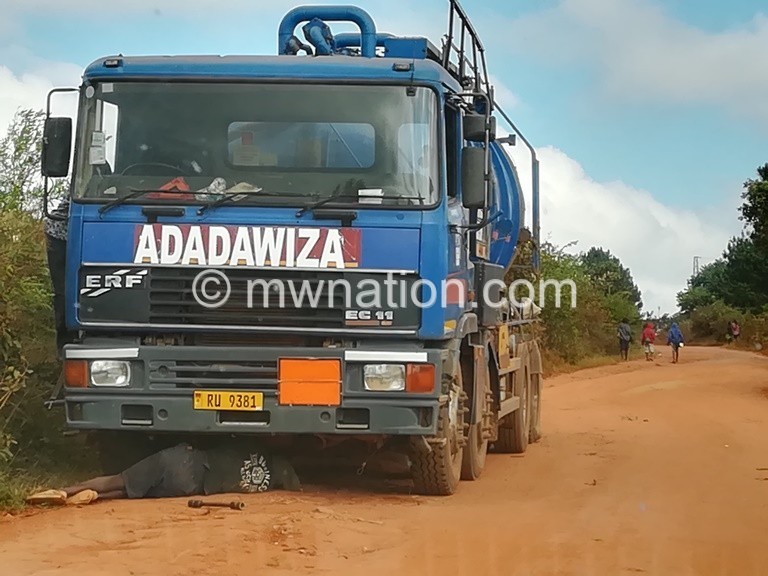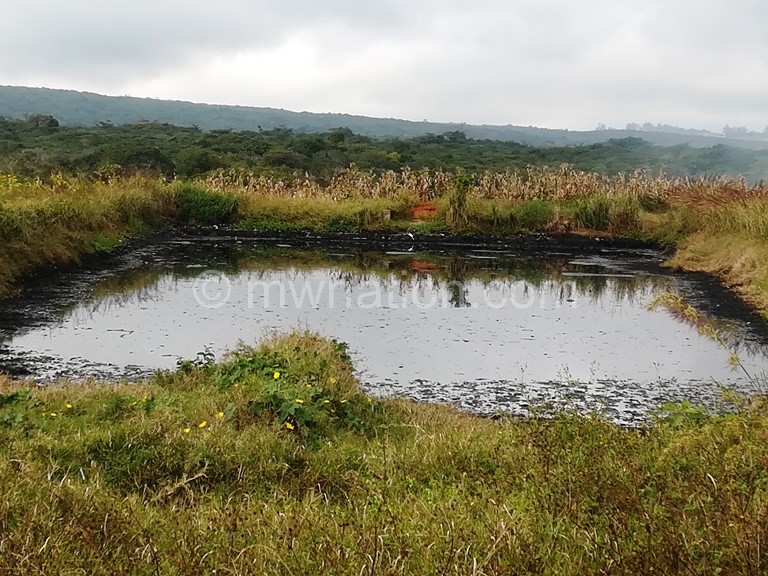As laws fail to converse, sanitation stutters
A conflict of laws and policies has led to malaise in faecal and liquid waste management in Malawian cities. For instance, city councils are mandated by the 1998 Local Government Act to provide and manage urban sewerage infrastructure. However, the 1995 Waters Works Act and the 2008 National Sanitation Policy give mandate to water boards. As the laws fail to speak with one language, JOHN CHIRWA lays bare how city residents face the risk of contracting sanitation-related infections.

A strong, putrid smell is the first thing that greets visitors at Mzuzu Sludge Ponds on the periphery of the city. As one enters the fenced site, a suffocating stench is felt in the air, strong and thick enough to cause one to choke and sputter.
This is the waste management site for liquid waste and sludge generated in the northern city of Mzuzu.
Apparently, Mzuzu has no conventional sewage system. Neither the Mzuzu City Council (MCC) nor the Northern Region Water Board (NRWB) has invested in constructing a conventional sewage system as the laws stipulate.
In the absence of such a system, households rely on on-site sanitation facilities like pit latrines and septic tanks. But challenges abound in pit latrine emptying and waste disposal.
“We just abandon the filled-up toilet and dig a new one,” says Mussa Mzumara, a landlord in the densely populated Salisbury Township on the edge of the Mzuzu Central Business District.
“But with land constraints in this high-density area, digging a new latrine becomes difficult. So, we prefer emptying the latrines manually using a shovel,” he adds.

Mzumara says these practices are common in most unplanned settlement areas of Masasa, Chibavi, Ching’ambo and Chiputula. Statistics indicate that over 60 percent of residents in Mzuzu stay in unplanned settlements.
“I use a shovel because I can’t manage to hire a vacuum truck to empty my pit latrine. But even if I could pay them, there is no passage for such vehicles here since Salisbury is an unplanned settlement with no access roads,” he says.
Mzumara owns a compound with four households which have a total of 17 people.
During our visit, we found that the compound has two pit latrines. However, one was full and abandoned, leaving all the 17 individuals with no choice but to depend on one pit latrine.
“Our biggest challenge is the high-water table as toilets fill up faster than anticipated, almost twice every year,” he says.
Mzuzu University (Mzuni) Centre of Excellence in Water and Sanitation technical programme officer Joshua Mchenga says the high population growth in cities has failed to match up with the slow pace at which proper toilets and sewerage management connections are coming up.
He says as such slum residents face many challenges in pit latrine emptying such that they are left with no choice but to depend on informal collectors.
“People living in informal settlement areas normally have limited space to dig another pit latrine when the existing one is full.
“However, disposal of trash like cloth, diapers and sanitary pads makes emptying of these pit latrines difficult as they clog emptying equipment. In addition, most latrines are unlined and this puts them at risk of collapsing during the emptying process,” he explains.
He says the informal pit latrine emptiers do not follow safety guidelines for emptying and disposal of faecal sludge most of the time. As a result, he says sludge finds its way into nearby water bodies; thereby, posing as a health risk.
“Unlined shallow wells are commonly used in informal settlements areas like Chibavi and Salisbury in Mzuzu. Due to limited space, they are mostly located close to pit latrines. This poses a high risk of ground water contamination,” he says.
In the absence of sewage system, Mzuzu has sludge ponds as a disposal site for sludge and liquid waste generated in the city. The site was rehabilitated by the Malawi Red Cross Society (MRCS).
Mzuzu City Council (MCC) spokesperson McDonald Gondwe says the council charges K10 500 per trip for sludge operators to use the dumping site.
“We usually have an officer who takes track of everything that happens at the facility,” he says.
But Mchenga says it is mostly formal emptiers who use the facility due to the high fees.
“There is need for further research to establish effectiveness of the sludge ponds in relation to its public health impact on the surrounding communities and water bodies,” he says.
However, our visit established that the fees somehow deter other operators and industries from using the site. These opt for the nearby crop fields on the banks of Ching’ambo River.
Mirriam Chilinda, 35, is one of the residents who suffered from poor liquid waste management at the site.
“Vacuum truck operators were dumping liquid and faecal waste in my crop field without my permission,” she says.
Chilinda’s crop field lies on the banks of Ching’ambo River. The river is a tributary of Lunyangwa, a river source of drinking water for the Northern Region Water Board (NRWB) and households living along it.
“In a day, they would make up to 20 trips to our gardens. It was until last year when our village head took the initiative to stop the operators from dumping sludge in our fields,” she says.
Yesaya Manda, who owns three plots of vegetables, says the sludge was on demand by some farmers whose fields were barren.
“We were of course happy that our crops were flourishing without enriching our soils with fertilizer,” he says.
The council publicist says his institution has an inspection team “that goes around to assess the environmental and health issues so that the facility serves its purpose”.
“The council considers the site as one of the potential aspects for future investment. Meanwhile, we are still exploring ways of improving the ponds and initiate recycling mechanism,” he says.
Sanitation specialists observe that the breakdown in sanitation is a national issue as human faecal matter is not safely collected, treated or disposed. For example, in Malawi, sewer systems are only present in two cities of Blantyre and Lilongwe.
However, studies indicate that even in these two cities, the otherwise treated water from wastewater treatment plants are discharged into water bodies with “large amounts of human faecal waste” which poses a health risk to humans.
Studies also indicate that surface and groundwater in these urban areas is heavily polluted with microbial and chemical contaminants.
In Blantyre, for instance, there are three municipal wastewater treatment plants, namely Blantyre, Soche and Limbe plants whose effluent is discharged into Mudi, Mlambalala and Limbe rivers, respectively.
A study which was conducted in 2010, led by Victor Chipofya of the University of Malawi (The Polytechnic), shows that the pollutant levels in effluent from the three treatment plants was above the recommended Malawi standards and the World Health Organisation (WHO) guidelines.
The pollutants include Biochemical Oxygen Demand and Total Suspended Solids (TSS). These are important water quality parameters because they provide an index to assess the effect that the discharged wastewater will have on the receiving environment. The higher the BOD value, the greater the amount of organic matter or “food” available for oxygen consuming bacteria, argues the study.
Sanitation specialist Jackson Mtungira says all these challenges boil down to the conflict of laws in the country.
He says this conflict affects coordination of sanitation works between water boards and councils.
“Due to this conflict, sanitation responsibilities are usually left to no one as either one thinks the responsibility is with them based on the act aligned to them or think the responsibility lies with the other stakeholder based on the other act,” he says.
He says there is need to harmonise these acts so that “it comes out clearly as to who is responsible for what” to ensure that there is smooth coordination between these two stakeholders.
“Both laws should talk the same language. Either they should recommend that waterborne sanitation should be assigned to the water boards as indicated in the Water Works Act or to councils.
“My suggestion is that waterborne sanitation should be assigned to water boards because wastewater comes from water usage. It is easier that way for water boards to estimate how much of the water consumed has gone into waste and therefore plan for its treatment than it would be with councils.
“Additionally, elsewhere water boards are able to incorporate a tariff for wastewater treatment in their water bills. This ensures that operations for wastewater treatment are running smoothly,” he argues.
The World Health Organisation (WHO) defines sanitation as the provision of facilities and services for safe disposal of human urine and faeces. Unicef figures show that about 57 million people practice open defecation (OD) with the rate of eliminating the practice estimated at 2.2 million people per year.
Speaking at a conference for science journalists in Kenya last year, sanitation specialist Sahr Kemoh said in order to effectively deal with it and eliminate open defecation by the targeted 2030 to attain sustainable development goal number six, the elimination rate has to more than double to reach at least 5.5 million people.
“Inadequate sanitation has been a major cause of diseases worldwide and it is feared that the high population growth will heighten disease burden for communicable diseases like cholera, typhoid, infectious hepatitis and polio, crypto most of which spread rapidly bringing sudden death to many people,” he said.





